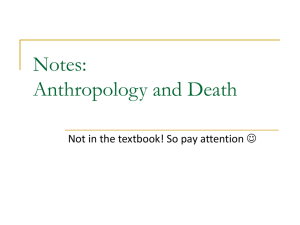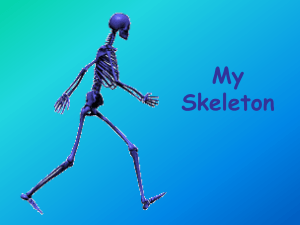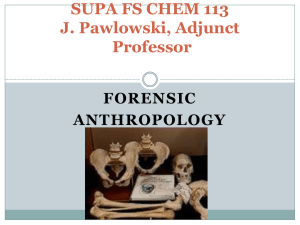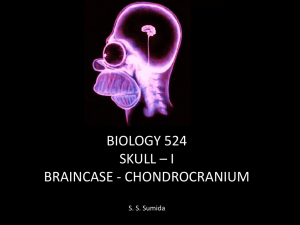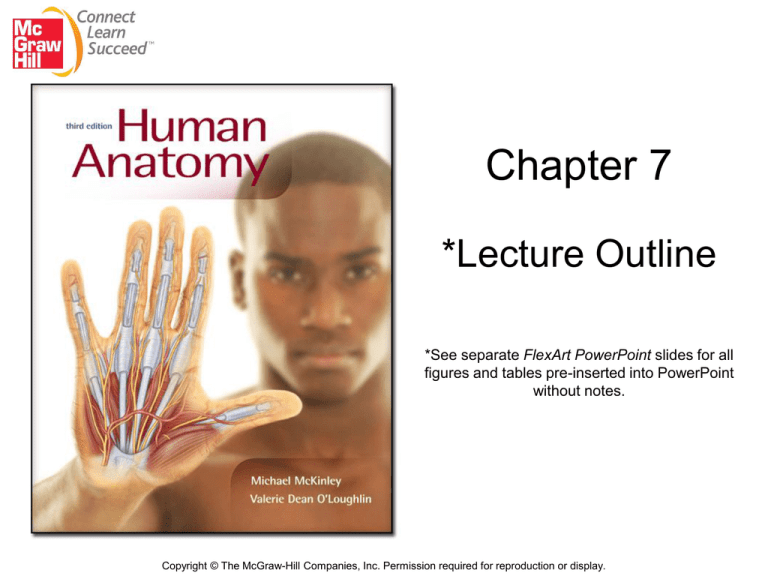
Chapter 7
*Lecture Outline
*See separate FlexArt PowerPoint slides for all
figures and tables pre-inserted into PowerPoint
without notes.
Copyright © The McGraw-Hill Companies, Inc. Permission required for reproduction or display.
Chapter 7 Outline
•
•
•
•
•
•
•
Skull
Sex Differences in the Skull
Aging of the Skull
Vertebral Column
Thoracic Cage
Aging of the Axial Skeleton
Development of the Axial Skeleton
Intro to the Skeleton
•
•
Typically 206 bones in the adult
Divided into two categories:
–
–
Axial skeleton: skull, vertebral column,
and thoracic cage (80 bones)
Appendicular skeleton: shoulder and hip
bones and those of the upper and lower
extremities (126 bones)
The Axial Skeleton
•
•
•
•
Skull: 22 bones
Skull associated bones: 7 bones
Vertebral column: 26 bones
Thoracic cage: 25 bones
TOTAL = 80 bones
Axial Skeleton
Figure 7.1
Axial Skeleton
AXIAL SKELETON = 80 BONES
Skull Bones
•
22 bones in two categories:
– Facial: 14 with no brain contact
– Cranial: 8 that form cranium and
have direct contact with the brain
The Skull and Associated Bones
Cranial=8 Bones
Cranial and Facial Subdivisions of the Skull
Facial = 14
Bones
Cranial vs. Facial Bones
Figure 7.2
Cranial Bones
•
8 cranial bones
– Frontal (1)
– Parietal (2)
– Temporal (2)
– Occipital (1)
– Sphenoid (1)
– Ethmoid (1)
Cranial Bones
Frontal Bone
Figure 7.10
Anterior View of Skull
Figure 7.4
Parietal Bones
Figure 7.11
Superior View of Skull
Figure 7.5
Posterior View of Skull
Figure 7.5
Temporal Bones
Figure 7.12
Occipital Bone
Copyright © The McGraw-Hill Companies, Inc. Permission required for reproduction or display.
Hypoglossal canal
Basilar part
Jugular notch
Basilar part
Hypoglossal canal
Groove for sigmoid sinus
Occipital condyle
Foramen magnum
Condylar canal
Foramen magnum
External
occipital crest
Internal occipital crest
Squamous
part
Internal occipital
protuberance
Groove for superior
sagittal sinus
Inferior
nuchal line
Superior
nucha line
Squamous part
(a) Occipital bone, external (inferior) view
Figure 7.13
Groove for
transverse sinus
Lambdoid suture
External occipital
protuberance
(b) Occipital bone, internal (superior) view
Lateral View of Skull
Figure 7.6
The Skull and Associated Bones
The Adult Skull (Lateral View)
Sphenoid Bone (Superior)
Figure 7.14
Internal View of Cranium
Figure 7.9
Sphenoid Bone (Posterior)
Figure 7.14
Inferior View of Skull
Figure 7.8
Ethmoid Bone
Figure 7.16
Sagittal View of Skull
Figure 7.7
Sutures
•
•
Immovable joints between skull bones
Four major sutures:
–
–
–
–
Coronal: between frontal and parietals
Lambdoid: between occipital and
parietals
Sagittal: between parietals
Squamous: between temporals and
parietals
Superior View of Sutures
Figure 7.5
Posterior View of Sutures
Figure 7.5
Lateral View of Sutures
Figure 7.6
Cranial Fossae
A fossa is a depression found in a bone(s).
There are three fossae in the cranium:
1. Anterior cranial fossa
2. Middle cranial fossa
3. Posterior cranial fossa
Cranial Fossae
Figure 7.17
Facial Bones
• 14 facial bones
– Zygomatic (2)
– Lacrimal (2)
– Nasal (2)
– Inferior nasal conchae (2)
– Palatine bones (2)
– Maxillae (2)
– Vomer (1)
– Mandible (1)
Copyright © The McGraw-Hill Companies, Inc. Permission required for reproduction or display.
Table 7.4
View
Sex Difference in the skull
Female skull
Male skull
Anterior View
Lateral View
Skull feature
Female skull Characteristic
Male skull Characteristic
Nuchal Lines and External
Occipital Protuberance
External surface of occipital bone is relatively
smooth, with no major bony projections
More robust (big and bulky), more prominent
muscle markings
Well-demarcated nuchal lines and prominent bump
or “hook” for external occipital protuberance
Mastoid Process
Relatively small
Large, may project inferior to external acoustic meatus
Squamous Part of Frontal
Bone
Usually more vertically oriented and rounded
than in males
Exhibits a sloping angle
Supra orbital Margin
Thin, sharp border
Thick, rounded, blunt border
Superciliary Arches
Little or noprominence
More prominent and bulky
Mandible (general features)
Smaller and lighter
Larger, heavier, more robust
Mental Protuberance (chin)
More pointed and triangular-shaped, less forward
projection
Squarish, more forward projection
Mandibular Angle
Typicallygreaterthan125degrees
Flared, less obtuse, less than 125 degrees (typically
about 90 degrees)
Sinuses
Smaller in total volume
Larger in total volume
Teeth
Relatively smaller
Relatively larger
General Size and Appearance More gracile and delicate
(all): © Ralph T. Hutchings/Visuals Unlimited
Zygomatic Bones
• Commonly referred to as the “cheekbones”
Figure 7.4
Zygomatic Bones
Figure 7.18
Lacrimal Bones
Figure 7.25
Nasal Bones
Figure 7.4
Inferior Nasal Conchae
Figure 7.7
Inferior Nasal Conchae
Figure 7.23
Palatine Bones
• Form the posterior 1/3 of hard palate
Figure 7.8
Palatine Bones
Figure 7.20
Maxillae
• Form the “upper jaw"
Figure 7.4
Maxillae
• Form the anterior 2/3 of hard palate
Figure 7.8
Maxillae
Figure 7.21
Vomer
• Forms lower half of nasal septum
Figure 7.7
Vomer
Figure 7.19
Mandible
• Known as the lower jaw
Figure 7.6
Mandible
Figure 7.22
Nasal Complex
• Bones and
cartilages forming
the nasal cavities
and sinuses
around them
Figure 7.23
Nasal Complex
• Superior border: cribriform plate of
ethmoid, parts of frontal and sphenoid
• Inferior border: maxillae and palatines
• Lateral walls: ethmoid, maxillae, inferior
nasal conchae, palatines, and lacrimals
TOTAL = 7 bones
Paranasal Sinuses
•
Air-filled spaces in skull bones around
nasal cavity
–
•
mucous lining humidifies and warms
inhaled air
Four major types:
–
–
–
–
Frontal
Ethmoid
Sphenoid
Maxillary
Orbital Complex
• Bony cavities in skull that hold and protect
the eye are the orbits
– consist of multiple bones
– also contain muscles that move the
eyes
Bones of the Orbital Complex
Figure 7.25
Bones of the Orbital Complex
• Roof: frontal bone and lesser wing of
sphenoid
• Floor: mainly the maxilla
• Medial wall: maxilla, lacrimal, and ethmoid
• Lateral wall: zygomatic, sphenoid, and
frontal
• Posterior wall: mainly the sphenoid bone
Bones Associated with the Skull
• Auditory ossicles: 3 tiny bones in each
temporal for hearing (see Chapter 19)
–
–
–
Malleus
Incus
Stapes
• Hyoid: located inferior to the mandible
–
–
does not articulate with another bone
attachment site for tongue and muscles of
larynx used in swallowing
Hyoid Bone
Figure 7.26
Aging of the Skull
• Infant cranial bones are connected by
flexible areas of dense regular connective
tissue called fontanelles
• Two major ones:
– Anterior: ossifies at about 15 months
– Posterior: ossifies around 9 months
Fontanelles
Figure 7.27
Vertebral Column
•
Comprised of 26 bones called vertebrae
–
24 individual bones divided into regions
•
•
•
–
7 cervical
12 thoracic
5 lumbar
2 inferior bones are fusions of several
vertebrae
•
•
sacrum
coccyx
Vertebral Column
Figure 7.28
Spinal Curvatures
•
Four adult vertebral curvatures:
– Cervical: curves anteriorly
– Thoracic: curves posteriorly
– Lumbar: curves anteriorly
– Sacral: curves posteriorly
Vertebral Column
Figure 7.28
Vertebral Anatomy
• Most exhibit common structural features
– typical vertebrae are:
• C3 – C7
• T1 – T12
• L1 – L5
Typical Vertebra
Figure 7.29
Other Vertebrae
• Atypical vertebrae: have a unique feature
or are missing a typical feature
– C1: Atlas
– C2: Axis
– Sacrum
– Coccyx
C1: The Atlas
• Articulates with condyles of occipital bone
• Has deep superior articular facets
• Lacks a body (the only vertebra that lacks
a body)
Figure 7.30
C2: The Axis
• Has an odontoid process or dens
– acts as the axis of rotation between the atlas
and the skull
Figure 7.30
Sacrum
•
•
Originally 5 vertebrae, usually fuse in the
third decade of life
Two major structures:
– Alae: anterolateral “wing-like”
projections
– Promontory: anteriosuperior edge of
1st vertebrae
Coccyx
• Originally 4 vertebrae, usually fuse in the third
decade of life
Figure 7.31
Thoracic Cage
•
•
Bony frame around chest composed of:
– Thoracic vertebrae posteriorly
– Ribs laterally
– Sternum anteriorly
Protects heart, lungs, trachea,
esophagus, and other thoracic organs
Thoracic Cage
Figure 7.32
Sternum
•
•
The “breastbone” on anterior midline
Comprised of 3 bones that fuse at
approximately 40 years of age
– Manubrium
– Body
– Xiphoid process
Sternum
Figure 7.32
Ribs
•
12 pair (in both males and females)
–
–
–
articulate posteriorly with thoracic
vertebrae
True ribs: pairs 1–7, articulate anteriorly
with the sternum via costal cartilages
False ribs: pairs 8–12, do not articulate
directly with sternum via their costal
cartilages
•
Floating ribs: pairs 11 and 12 do not
articulate with any bone anteriorly
Ribs
•
Major structures:
– Head
•
–
–
–
–
with superior and inferior articular
facets
Tubercle
Angle
Shaft
Costal groove
Rib Articulations
•
•
Ribs 2–9 articulate posteriorly in 3 places
– head between 2 bones and the
tubercle
For instance, rib 6 articulates with:
– inferior demifacet of T5
– superior demifacet of T6
– transverse process of T6
Rib Structure and Articulation
Figure 7.33






